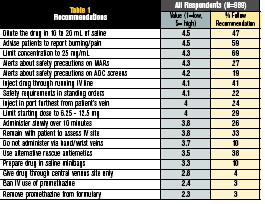VA MedSAFE recommendations include:
1. Local facilities must review their current practices regarding administration of promethazine HCl injection.
2. Local facilities must create individual protocols for use of promethazine HCl injection.
3. Local Pharmacy and Therapeutics (P&T) Committees must determine instances where use of promethazine HCl injection is absolutely necessary.
4. Providers and clinicians must refer to the Protocol for the Use of Antiemetics to Prevent Chemotherapy-Induced Nausea and Vomiting and Post-Operative Nausea and Vomiting at
http://vaww.pbm.va.gov/criteria/antiemeticdosing.pdf for alternative agents, such as parenteral prochlorperazine and parenteral ondansetron.
5. If promethazine must be used, providers and clinicians must follow recommendations per the package insert, ISMP, and VA MedSAFE.
6. Establish safeguards and alerts at each step of the medication use process (ordering, verifying, dispensing, and administration) to prevent of the potential risk of tissue injury, limb impairment, and possible loss of extremity associated with the use of the injectable form of promethazine HCl.
7. Educate providers and other health care staff on the proper administration technique of promethazine HCl injection to prevent tissue injury.
8. Educate providers and other health care staff as to which signs/symptoms to monitor for inadvertent intraarterial injection or perivascular extravasation.
9. Educate patients to report symptoms of pain or burning during or after the administration of promethazine HCl injection.


